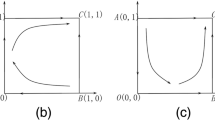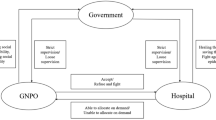Abstract
The healthcare alliance (HA) of malignant tumor specialist can promote the integration and development of tumor medical resources and play an important role in safeguarding people’s health. Nevertheless, conflicting interests between the involved stakeholders in the alliance impede the implementation of HA with effect. This paper divided the study of incentive coordination mechanism of supply chain in HA into two basic games, that is, under the government and medical insurance institution intervention, we respectively constructed the evolutionary game model between the tumor HA and patients, tertiary hospitals (TH) and member hospitals (MH) that are low utilized (eg. Secondary and Primary hospitals) within the alliance. Then the evolutionary stable strategies for two participants of each game are discussed and the influence of key parameters on the evolution trajectory are analyzed. Finally, numerical simulations are conducted to verify the theoretical results. The results found that “differentiated reimbursement rates for medical insurance”, “increasing government subsidies”, “enhancing the reputational impact of the different strategies of the HA” and “reducing the support costs of HA to MH” are conducive to improving primary medical service capabilities and guiding patients to go to PH for the first diagnosis. In addition, “increasing government subsidies”, “reducing sharing spillover effect caused by unilateral cooperation” and “reducing the costs of cooperation” can promote both sides to collaborate with each other to form a community of interests. Moreover, the initial strategy proportion of stakeholders would affect the evolutionary trajectories.






Similar content being viewed by others
References
Billingsley KG, Schwartz DL, Lentz S (2002) The development of a tele-medical tumor center within the Veterans Affairs Health Care System: a report of preliminary clinical results. Telemed J E Health 8(1):123–130
Chen WH, Zhang ZG, Hua ZS (2015) Analysis of two-tier public service systems under a government subsidy policy. Comput Ind Eng 90:146–157
Chen X, Zhao L, Liang H et al (2019) Matching patients and healthcare service providers: a novel two-stage method based on knowledge rules and OWA-NSGA-II algorithm. J Comb Optim 37(1):221–247
Chen Y, Ding S, Zheng H, Zhang Y, et al. (2018). Exploring diffusion strategies for mHealth promotion using evolutionary game model. Appl Math Comput 336:148–161. https://doi.org/10.1016/j.amc.2018.04.062
Guan X, Zhang ZW, Chen ZL et al (2019) The evolutionary game model of medical dispute under the regulation of the government. Syst Eng Theory Practice 39(12):3151–3162
Fan X, Tang J, Yan C, Guo H, et al. (2019). Outpatient appointment scheduling problem considering patient selection behavior: data modeling and simulation optimization. J Comb Optim. https://doi.org/10.1007/s10878-019-00487-x
Fuertes JN, Toporovsky A, Reyes M (2017) The physician-patient working alliance: Theory, research, and future possibilities. Patient Educ Couns 100(4):610–615
Gan YQ, You MX, Hu K (2014) Reimbursement gap, patient behavior and medical expenses-A three-stage dynamic game analyses. Syst Eng-Theory Practice 34(11):2794–2983
Gao X, Wen J, Song J (2018) Simulation study of revenue sharing in healthcare alliances. In: 2018 winter simulation conference (WSC), 2680–2689.
Gao X, Wen J, Song J (2019) Capacity allocation and revenue sharing in healthcare alliances. Flexible Serv Manuf J. https://doi.org/10.1007/s10696-019-09356-5
Gao Z, Gai AL, Zhou J (2017) Current situation of tumor prevention and two-way referral under the new rural cooperative medical system in a pilot region of Hubei province. China Tumor. l26(5): 327–332
Guo PF, Tang CS, Wang YL et al (2019) The impact of reimbursement policy on social welfare, revisit rate, and waiting time in a public healthcare system: fee-for-service versus bundled payment. Manuf Serv Oper Manag 21(1):154–170
Hua Z, Chen W, Zhang ZG (2016) Competition and coordination in two-tier public service systems under government fiscal policy. Prod Oper Manag 25(8):1430–1448
Li N, Kong N, Li Q et al (2017a) Evaluation of reverse referral partnership in a tiered hospital system–A queuing-based approach. Int J Prod Res 55(19):5647–5663
Li N, Pan J, Xie X, et al (2017) Operational decision making for a referral coordination alliance- When should patients be referred and where should they be referred to? Omega,1–7.
Li XP (2015) Analysis on evolution game equilibrium on the stakeholders of public hospitals. Chinese Health Econom 34(2):86–89
Li ZP, Wang JJ, Shan W (2019) Downstream referral decisions and payments mechanism in a hierarchical healthcare system. Syst Eng-Theory Practice 30(8):2126–2137
Liu X, Cai X, Zhao R, Lan Y (2015) Mutual referral policy for coordinating health care systems of different scales. Int J Prod Res 53(24):7411–7433
Liu XY, Deng QZ (2016) Mutual referral policy for coordinating different-level hospitals in the medical association. Indust Eng Manag 21(04):137–146
Sun KX, Zheng RS, Zhang SW et al (2019) Report of tumor incidence and mortality in different areas of china, 2015. China Tumor 28(1):1–11
Wang AQ, Yin WQ, H Y, et al (2019) Analysis on the behavioral strategies of the core hospitals in medical alliance and patients based on the evolutionary game theory. Chinese Health Econom 38(5):8–11
Wang J, Li Z, Shi J, et al (2020) Hospital referral and capacity strategies in the two-tier healthcare systems. Omega. https://doi.org/10.1016/j.omega.2020.102229
Wang ZG, Feng JF (2020) Tiered medical system of tumor promoted by cancer hospital union. Chin J Surg Oncol 12(5):385–386
Xu XX, Li YM, Lin QQ (2019) Experience and reflection on the construction of medical alliances in a government and hospital partnership model. Chin J Hosp Admin 35(11):903–906
Yang YW (2015) Research on cooperative game in a medical joint venture based on game theory. Hospital Management Forum 32(12):2–8
Zheng L (2016) Improving the primary doctors’ medical service capacity was the key to promote hierarchical diagnosis system. Chinese Health Economics 35(9):67–69
Zhou W, Wan Q, Zhang R (2017) Choosing among hospitals in the subsidized health insurance system of China: A sequential game approach. Eur J Oper Res 257(2):568–585
Zou XX, Cheng J, Zhang WW (2015) Strategy analysis of the development of hierarchical medical service system in China: based on game theory. Chin Hosp 35(07):24–26
Author information
Authors and Affiliations
Corresponding author
Additional information
Publisher's Note
Springer Nature remains neutral with regard to jurisdictional claims in published maps and institutional affiliations.
Rights and permissions
About this article
Cite this article
Gao, G., Wu, Z. & Wang, S. Study on the incentive and coordination mechanism of tumor healthcare alliance based on evolutionary game. J Comb Optim 44, 2577–2597 (2022). https://doi.org/10.1007/s10878-021-00763-9
Accepted:
Published:
Issue Date:
DOI: https://doi.org/10.1007/s10878-021-00763-9




